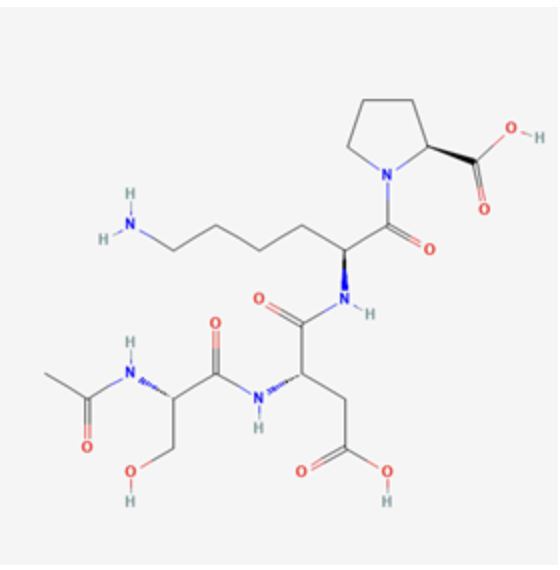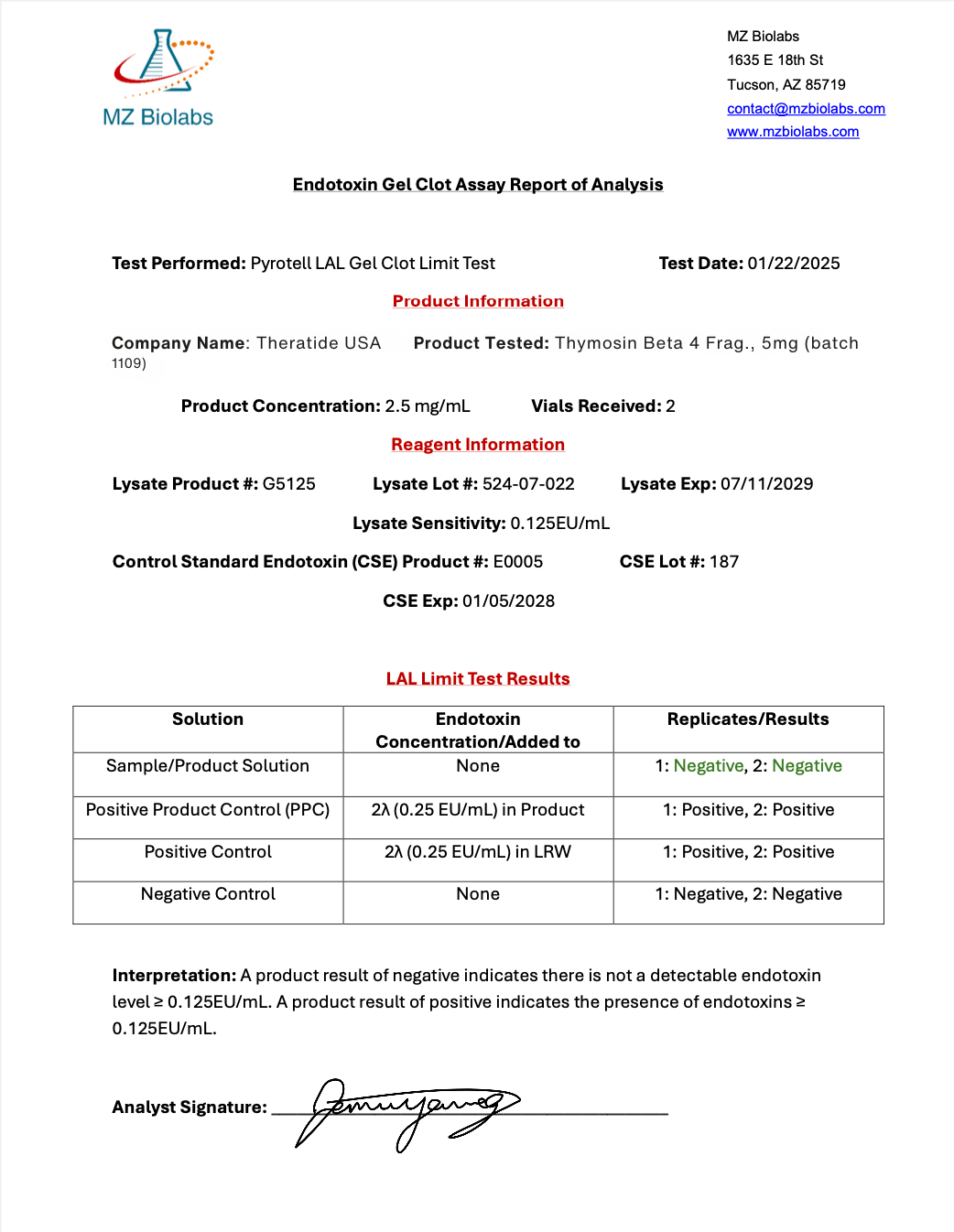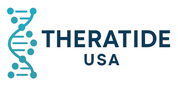Product Overview
Product Overview
Thymosin Beta-4 Fragment (1–4) (Ac-SDKP) Overview
Ac-SDKP (N-acetyl-seryl-aspartyl-lysyl-proline) is a naturally occurring tetrapeptide derived from the large thymosin beta-4 protein. Research in animal models has shown Ac-SDKP to have anti-inflammatory, pro-angiogenic, and anti-scarring properties. It has been proposed as a potential therapeutic agent for a variety of conditions, including cardiovascular disease, kidney and liver fibrosis, and inflammatory bowel disease. The peptide may even offer a more natural mechanism for the treatment of high blood pressure, in part due to its association with angiotensin-converting enzyme.
Structure

Sequence: Ac-Ser-Asp-Lys-Pro
Molecular Formula: C20H33N5O9
Molecular Weight: 487.5 g/mol
CAS Number: 120081-14-3
Synonyms: goralatide, seraspenide
Mechanism of Action & Research
At its most basic level, Ac-SDKP works by modulating the immune response. In animal models it has been shown to activate certain immune pathways responsible for bolstering anti-inflammatory responses, modulating the release of proinflammatory factors, reducing tissue infiltration by T-cells, and promoting the differentiation and migration of macrophages. It is also known to suppress production of TGF-beta, a driver of fibrosis, and to inhibit oxidative stress. Research suggests its activity is mediated through MEK-ERK signaling, contributing to reduced collagen synthesis, reduced scar tissue, and improved healing outcomes.
Anti-Inflammatory and Fibrosis Effects
Ac-SDKP reduces macrophage activation, inflammatory cytokine release, and prevents fibrotic conversion of fibroblasts. In animal models of inflammatory bowel disease, heart fibrosis, and kidney disease, Ac-SDKP has been shown to significantly improve tissue health and reduce markers of damage. In models of heart injury, it even reverses established fibrosis and improves cardiac function.
Additional Research Highlights
- Protective effects against high blood pressure through ACE pathway modulation
- Potential use as an adjuvant to chemotherapy and radiotherapy to reduce tissue damage
- Evidence for protective and regenerative effects in the brain after stroke, due to its ability to cross the blood-brain barrier and regulate fibrin activity
Referenced Citations
- U. Sharma et al., “Novel anti-inflammatory mechanisms…”
- N. Kumar et al., “The anti-inflammatory peptide Ac-SDKP…”
- Y. Shi et al., “N-Acetyl-Ser… Mitigates Experimental Colitis…”
- H. Peng et al., “Ac-SDKP inhibits transforming growth factor…”
- and so on…
Disclaimer
ALL ARTICLES AND PRODUCT INFORMATION PROVIDED ON THIS WEBSITE ARE FOR INFORMATIONAL AND EDUCATIONAL PURPOSES ONLY.
The products offered on this website are furnished for in-vitro studies only. In-vitro studies (Latin: in glass) are performed outside of the body. These products are not medicines or drugs and have not been approved by the FDA to prevent, treat, or cure any medical condition, ailment, or disease. Bodily introduction of any kind into humans or animals is strictly forbidden by law.

Storage Instructions
All of our products are manufactured using the Lyophilization (Freeze Drying) process, which ensures that our products remain stable for shipping for up to 3–4 months. Once reconstituted, they must be stored in the fridge and used within 30 days.
TB-500 vs. TB-500 Fragment (1–4): Which One Should You Research?
Two peptides. Two approaches to healing. Here’s what makes them different — with real-world examples.
TB-500 – The Proven, All-Around Healing Peptide
TB-500 is the full version of Thymosin Beta-4. It’s been the go-to choice in research for years, because it works on many aspects of healing at once.
✅ What it’s good for:
- Helping sports injuries like torn ligaments and tendons heal faster.
- Improving recovery after surgical wounds or burns.
- Supporting tissue repair after eye damage or heart injury.
- Reducing overall inflammation and swelling.
Practical research examples:
- Studying faster tendon healing in athletes.
- Testing improved recovery of skin grafts in burn victims.
- Looking at how damaged heart muscle heals after a mild heart attack.
Why choose it? If you want a proven, all-around healing peptide for general repair, TB-500 is the better choice.
TB-500 Fragment (1–4) – The Targeted, Experimental Option
The Fragment is just the active tip of TB-500 — the first 4 amino acids — believed to be responsible for helping cells move into damaged areas to rebuild tissue. It’s much more specific, and still experimental.
✅ What it’s good for:
- Research that wants to isolate and study just the cell migration part of healing — without added effects like increased blood vessel growth.
- Exploring how skin cells close wounds more efficiently (useful for scar-minimization research).
- Studying how connective tissue cells move and arrange to form healthy tissue instead of scar tissue.
- Investigating how to control healing in delicate or cosmetic areas, where too much new tissue or inflammation is undesirable.
Practical research examples:
- Testing new wound dressings designed to help skin heal with less scarring.
- Research on cosmetic procedures to improve post-laser or microneedling recovery while keeping inflammation low.
- Studying fibroblast and keratinocyte (skin cell) movement in thin, delicate tissue like eyelids or lips.
- Developing treatments for ulcers or slow-healing diabetic wounds where controlled cell movement — not aggressive angiogenesis — is the goal.
Why choose it? If you want to study the very specific process of cell migration and wound closure, especially in sensitive or cosmetic areas, the Fragment is the right choice.
Quick Comparison Table
| TB-500 (Full) | TB-500 Fragment (1–4) | |
|---|---|---|
| Best for | General healing, inflammation, recovery | Targeted cell movement, precise wound closure |
| Examples | Torn ligaments, burns, heart recovery | Scar reduction, cosmetic healing, diabetic ulcers |
| Proven? | Well-studied and reliable | Very early-stage and experimental |
? In Summary:
Choose TB-500 full if you want to promote healing, reduce inflammation, and improve recovery across the board.
Choose TB-500 Fragment if you want to focus on just cell migration and wound closure, especially in sensitive, cosmetic, or controlled-healing scenarios.
All ARTICALS AND PRODUCT INFORMATION PROVIDED ON THIS WEBSITE ARE FOR INFORMATIONAL AND EDUCATTIONAL PURPOSES ONLY. The products offered on the website are furnished for in-vitro studies only. In-vitro studies (Latin: in glass) are performed outside of the body. These products are not medicines or drugs and have not been approved by the FDA to prevent, treat, or cure any medical condition, ailment, or disease. Bodily introduction of any kids into humans or animals is strictly forbidden by law.








